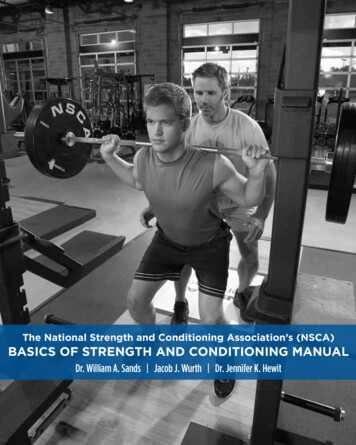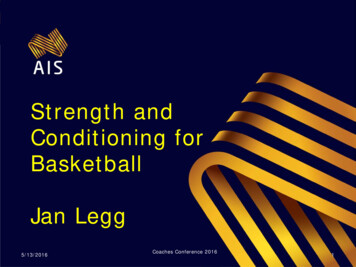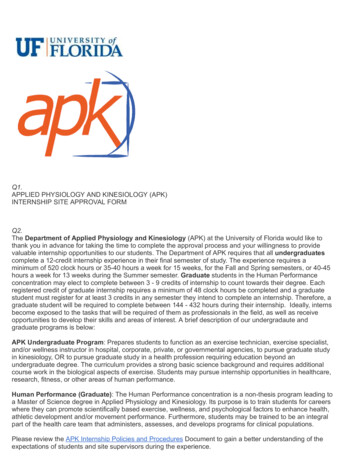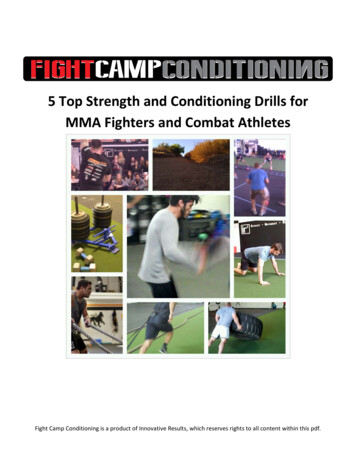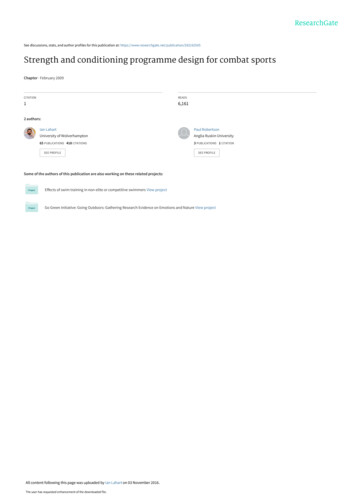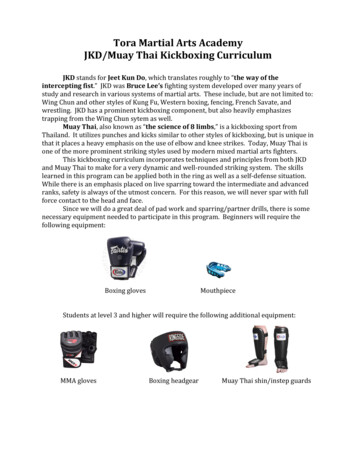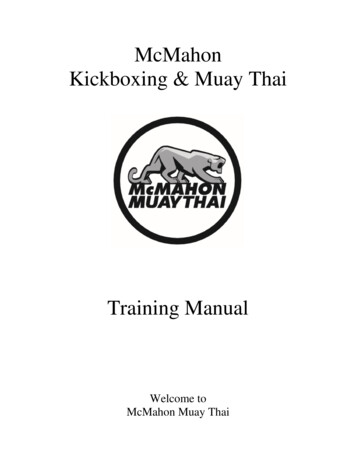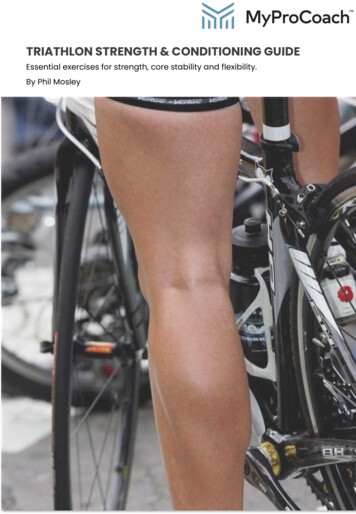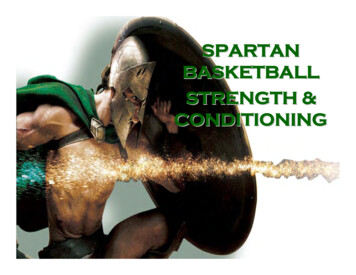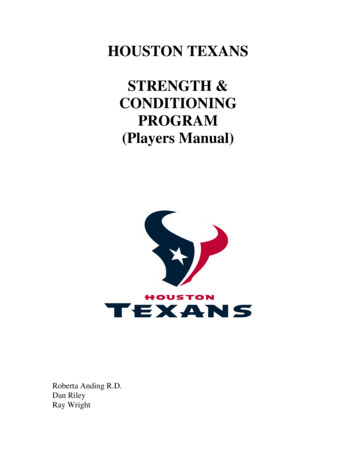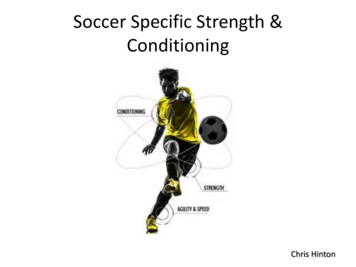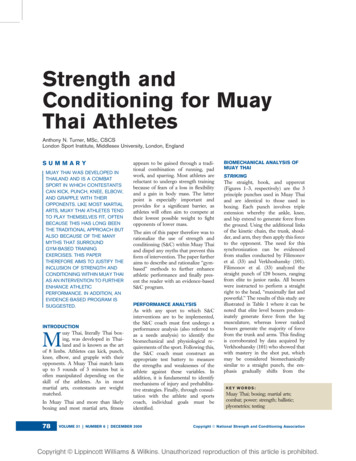
Transcription
Strength andConditioning for MuayThai AthletesAnthony N. Turner, MSc, CSCSLondon Sport Institute, Middlesex University, London, EnglandSUMMARYMUAY THAI WAS DEVELOPED INTHAILAND AND IS A COMBATSPORT IN WHICH CONTESTANTSCAN KICK, PUNCH, KNEE, ELBOW,AND GRAPPLE WITH THEIROPPONENTS. LIKE MOST MARTIALARTS, MUAY THAI ATHLETES TENDTO PLAY THEMSELVES FIT, OFTENBECAUSE THIS HAS LONG BEENTHE TRADITIONAL APPROACH BUTALSO BECAUSE OF THE MANYMYTHS THAT SURROUNDGYM-BASED TRAININGEXERCISES. THIS PAPERTHEREFORE AIMS TO JUSTIFY THEINCLUSION OF STRENGTH ANDCONDITIONING WITHIN MUAY THAIAS AN INTERVENTION TO FURTHERENHANCE ATHLETICPERFORMANCE. IN ADDITION, ANEVIDENCE-BASED PROGRAM ISSUGGESTED.INTRODUCTIONuay Thai, literally Thai boxing, was developed in Thailand and is known as the artof 8 limbs. Athletes can kick, punch,knee, elbow, and grapple with theiropponents. A Muay Thai match lastsup to 5 rounds of 3 minutes but isoften manipulated depending on theskill of the athletes. As in mostmartial arts, contestants are weightmatched.MIn Muay Thai and more than likelyboxing and most martial arts, fitness78appears to be gained through a traditional combination of running, padwork, and sparring. Most athletes arereluctant to undergo strength trainingbecause of fears of a loss in flexibilityand a gain in body mass. The latterpoint is especially important andprovides for a significant barrier, asathletes will often aim to compete attheir lowest possible weight to fightopponents of lower mass.The aim of this paper therefore was torationalize the use of strength andconditioning (S&C) within Muay Thaiand dispel any myths that prevent thisform of intervention. The paper furtheraims to describe and rationalize ‘‘gymbased’’ methods to further enhanceathletic performance and finally present the reader with an evidence-basedS&C program.PERFORMANCE ANALYSISAs with any sport to which S&Cinterventions are to be implemented,the S&C coach must first undergo aperformance analysis (also referred toas a needs analysis) to identify thebiomechanical and physiological requirements of the sport. Following this,the S&C coach must construct anappropriate test battery to measurethe strengths and weaknesses of theathlete against these variables. Inaddition, it is fundamental to identifymechanisms of injury and prehabilitative strategies. Finally, through consultation with the athlete and sportscoach, individual goals must beidentified.VOLUME 31 NUMBER 6 DECEMBER 2009BIOMECHANICAL ANALYSIS OFMUAY THAISTRIKINGThe straight, hook, and uppercut(Figures 1–3, respectively) are the 3principle punches used in Muay Thaiand are identical to those used inboxing. Each punch involves tripleextension whereby the ankle, knee,and hip extend to generate force fromthe ground. Using the additional linksof the kinetic chain, the trunk, shoulder, and arm, they then apply this forceto the opponent. The need for thissynchronization can be evidencedfrom studies conducted by Filimonovet al. (33) and Verkhoshansky (101).Filimonov et al. (33) analyzed thestraight punch of 120 boxers, rangingfrom elite to junior ranks. All boxerswere instructed to perform a straightright to the head, ‘‘maximally fast andpowerful.’’ The results of this study areillustrated in Table 1 where it can benoted that elite level boxers predominately generate force from the legmusculature, whereas lower rankedboxers generate the majority of forcefrom the trunk and arms. This findingis corroborated by data acquired byVerkhoshansky (101) who showed thatwith mastery in the shot put, whichmay be considered biomechanicallysimilar to a straight punch, the emphasis gradually shifts from theKEY WORDS:Muay Thai; boxing; martial arts;combat; power; strength; ballistic;plyometrics; testingCopyright Ó National Strength and Conditioning Association
As illustrated in Figures 4–7, Tripleextensions movements are also requiredfor kicking, kneeing, and elbowing. Thedevelopment of this synchronizationand use of triple extension–based exercises may therefore be consideredessential to the generation of forcewithin Muay Thai. Weightlifting andthe associated lifts are often hypothesized to provide an appropriate stimulusfor motor skills requiring triple extension (52,59,61,93). Moreover, the second pull position (Figure 8) providesa biomechanical comparison with thepunching start position; therefore, sportspecificity can be further gained bycommencing lifts from this position.Figure 1. Straight.shoulder to the leg musculature. Thisinvestigation revealed that for beginners, the correlation between athleticachievements and strength of the armmuscles is 0.83 and with leg strength is0.37. For highly qualified athletes,however, the correlations were 0.73and 0.87, respectively.To further facilitate the development ofoptimal synchronization patternswithin the kinetic chain, and assist inthe carryover of triple extension–basedexercises to Muay Thai techniques,a derivative of complex training,termed ‘‘carry-over training,’’ is recommended (see 25,27 for a review ofcomplex training). In this context,however, the objective is not thepotentiation of force (although thismay be an outcome) but rather thecarryover of neuromuscular stimulus/firing sequence. For example, an athletemay perform a set of power snatches(often from the second pull/hang),followed by performing straightpunches to the bag during the restperiod. The athlete is encouraged tovisualize the carryover and draw comparisons with the 2 forms of tripleextension and in effect, regard thepunch as synonymous with the powersnatch. It is important to only performa few punches (usually 3 per arm) andensure the emphasis lies with powergeneration with enough rest betweenreps to minimize fatigue. It is hypothesized that this will assist in neuraldevelopment and carryover, ultimatelyfacilitating an increase in force production when striking. This form ofcarryover training is currently beingtested within our laboratory to providean objective assessment of its validity.REACTIVE STRENGTHFigure 2. Hook.Reactive strength, which describesthe stretch-shortening cycle (SSC)Strength and Conditioning Journal www.nsca-lift.org79
S&C for Muay ThaiOptimization of SSC mechanics dictates that these movements, which (inthe opinion of the author) may beconsidered biomechanically similar tosprint running (whereby the knee is‘‘punched’’ forward and then the leg isquickly driven back down into theground), require that ground contactbe made via a forefoot landing only(51,69), thus minimizing ground contact time (GCT; 4,55,71), increasingenergy return (and thus striking force;51,69) and rate of force development(RFD; 13), and reducing the durationand metabolic cost of movement(11,12,24,100,102).Figure 3. Uppercut.capabilities of an athlete, may also beconsidered fundamental to force generation within Muay Thai. It is welldocumented that efficient SSC mechanics result in enhanced propulsiveforces (11,14,15) and conservation ofenergy (12,100,102), and this thereforesuggests that within martial arts, thismay translate into enhanced powerand power endurance of striking. As anexample, double kicks or consecutiveknees to an opponent require that aftereach strike, the leg is quickly drivenback down into the ground and thenquickly driven back up toward theopponent. In addition, when the athlete wants to deliver a powerful strikewith the front leg, they must firstswitch stance (change from a left footforward, right foot back stance, toa right foot forward, left foot backstance), thus allowing the kicking leg todevelop sufficient power through theSSC mechanism (Figure 9–11).This SSC efficiency, however, isa learned ability gained through thegeneration of muscle stiffness, therebyoptimally using the elastic recoil properties of the tendon (3,24,53,55,70,73).Muscle stiffness, however, is under thesubconscious control of the nervoussystem, whereby the Golgi tendonorgan (GTO) inhibits the generationof high forces (and muscle stiffness) asa protective mechanism against the riskof injury (88). Through observationsmade by this author, most athletes donot train SSC mechanics (enablingGTO disinhibition) beyond that gainedfrom their sports practice. This isillustrated by the fact that the majorityof athletes make heel contact, which issuggestive of a prolonged amortizationphase and muscle compliance consequent to GTO inhibition (34).It appears evident therefore thatsports practices do not provide sufficient stimulus for this adaptationand that purposeful exercises suchas plyometrics must be includedTable 1Level of mastery and the contribution to punching force by key components of the kinetic chain (33)Arm extension(%)Trunk rotation(%)Push off with extensionof back leg (%)Total(%)Masters of sport and candidatesfor masters of sport24.1237.4238.46100Class I25.9441.8432.22100Classes II and III37.9945.5016.51100Category80VOLUME 31 NUMBER 6 DECEMBER 2009
Figure 4. Elbow.(72,75,78,82,85,88,90). For example,Kyrolainen et al. (72) reported that 4months of plyometric training, consisting of various jumping exercises suchas drop jumps, hurdle jumps, andhopping, was required for the disinhibition of the GTO and the generationof muscle stiffness (concurrent withpre-activation tensioning and antagonistic cocontraction). Moreover, aswell as takeoff velocity increasing by8%, energy expenditure decreased by24% suggesting that adaptations fromthis plyometrics protocol also resultedin a reduction in the metabolic cost ofthese movements (72). It appearsapparent therefore that chronic plyometrics training is required to not onlycondition the Muay Thai athlete toincrease striking forces of this naturebut also facilitate them in employingthese strikes with regularity (aid thedevelopment of power endurance).Finally, inherent to plyometric exercises is the powerful execution of tripleextension (as previously described), sothese exercises are also likely to havea carryover to kicking and punchingmechanics and striking power.Figure 5. Push kick.Appropriate plyometric drills includedrop lands (Figure 12; ensuring theathlete initiates the exercise by stepping from the box, Figure 13) wherebythe body is hypothesized to adapt tohigh landing forces (eccentric loads)and disinhibition of the GTO is learned(105). This drill may then be progressedto drop jumps whereby the focus shiftsto reducing the amortization phase andGCT and thus the loss of elastic energy(34). It may be prudent, however, tocommence plyometric training withankling/stiff leg hops (Caption 1),which enhance the stiffness of theankle joint, as overall leg stiffness hasbeen reported to largely depend onankle stiffness (4,31,32). Of course, theS&C coach must determine safe andconducive plyometric intensities (e.g.,drop height). It may be appropriatetherefore to first practice landing drillsby jumping up to a box (Figure 14) orsimply jumping forward along theground, as the intensity of each is lessthan when dropping from a box.Strength and Conditioning Journal www.nsca-lift.org81
S&C for Muay Thaipowerlifting (i.e., back squat, deadlift,and bench press) produce approximately 12 W/kg of body weight (40).However, during the second pull phaseof both the clean and the snatch, anaverage of 52 W/kg of body weight isproduced (40).Figure 6. Roundhouse kick.FORCE GENERATIONCHARACTERISTICSBoxing movements (i.e., punches) involve contraction times of 50–250 ms(1). As described earlier, GCT duringdouble kicks and knees should (anecdotally) resemble that of sprint runningwhere this has been reported to be 101ms (77). Muay Thai motor skillstherefore, like the vast majority ofathletic movements, occur within250–300 ms (93,104) and the opportunity to develop peak force, whichmay require up to 600–800 ms (29,68),is not a time luxury afforded to theseathletes. This therefore suggests theneed for these athletes to developpower.It is hypothesized that if the timeavailable for force development is lessthan 0.3 seconds (as is the case in MuayThai), training should focus on improving RFD (80,87,105). BecauseRFD is a function of neuromuscularactivation (86) and is representative ofan individual’s ability to accelerateobjects (87), many authors recommendballistic (explosive) training to improvethis quality (10,43,45,46,103). It is82generally recognized that althoughheavy resistance training improvesthe final height of the force-time (FT) curve, ballistic training improves theslope of the initial portion of the F-Tcurve, specifically within the first 200–300 ms (45,80) when striking is mostlikely to occur.Ballistic exercises can best be describedas explosive movements (rapid acceleration against resistance) whereby thebody or object is explosively subjectedto full acceleration. Reviews by Flanagan and Comyns (34) and Hori et al.(58) recommended the use of plyometric training and weightlifting, respectively, to train RFD, as in additionto their ability to be adapted to thespecifics of the sport, they encouragefull acceleration with zero velocityachieved only by the effects of gravity.In addition, weightlifting producessome of the highest power outputs ofany exercise modality. For example,Garhammer (40) reported that thesnatch and clean and jerk exhibit muchgreater power outputs compared withthe squat and deadlift. For example, therelatively slow velocities involved inVOLUME 31 NUMBER 6 DECEMBER 2009It should be noted that a high and positive correlation exists between peakpower and maximum strength (r 0.77–0.94; 6), illustrating the significance of strength training as a prerequisite to power development. Withthis in mind and because strengthlevels may only be maintained forapproximately 2 weeks (60), it isadvisable to include strength sessionsthroughout the entirety of a periodizedprogram so as to optimize and maintain high levels of power output. Infurther support of using a combinedstrength and power training approach,Cormie et al. (21), Harris et al. (50), andToji et al. (96) concluded that whenconsidering the improv
opponents. A Muay Thai match lasts up to 5 rounds of 3 minutes but is often manipulated depending on the skill of the athletes. As in most martial arts, contestants are weight matched. In Muay Thai and more than likely boxing and most martial arts, fitness appears to be gained through a tradi-tional combination of running, pad work, and .
